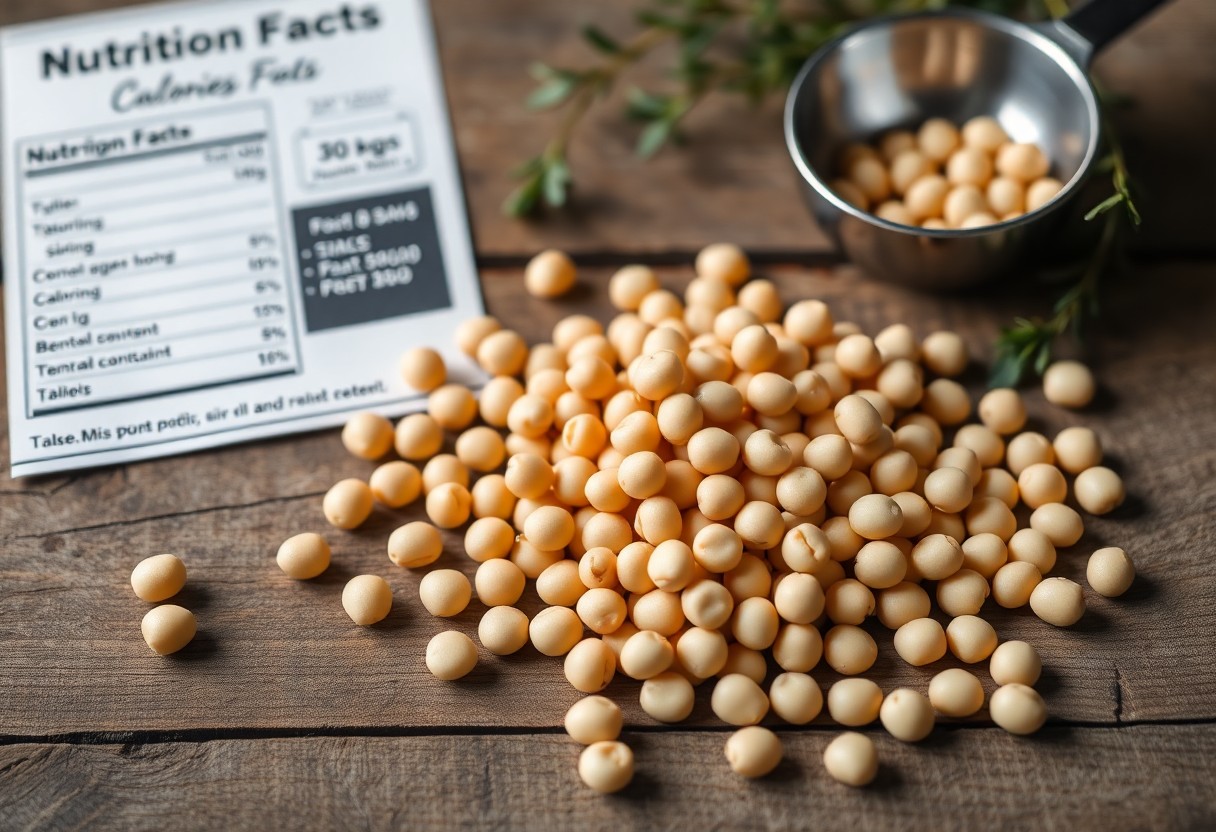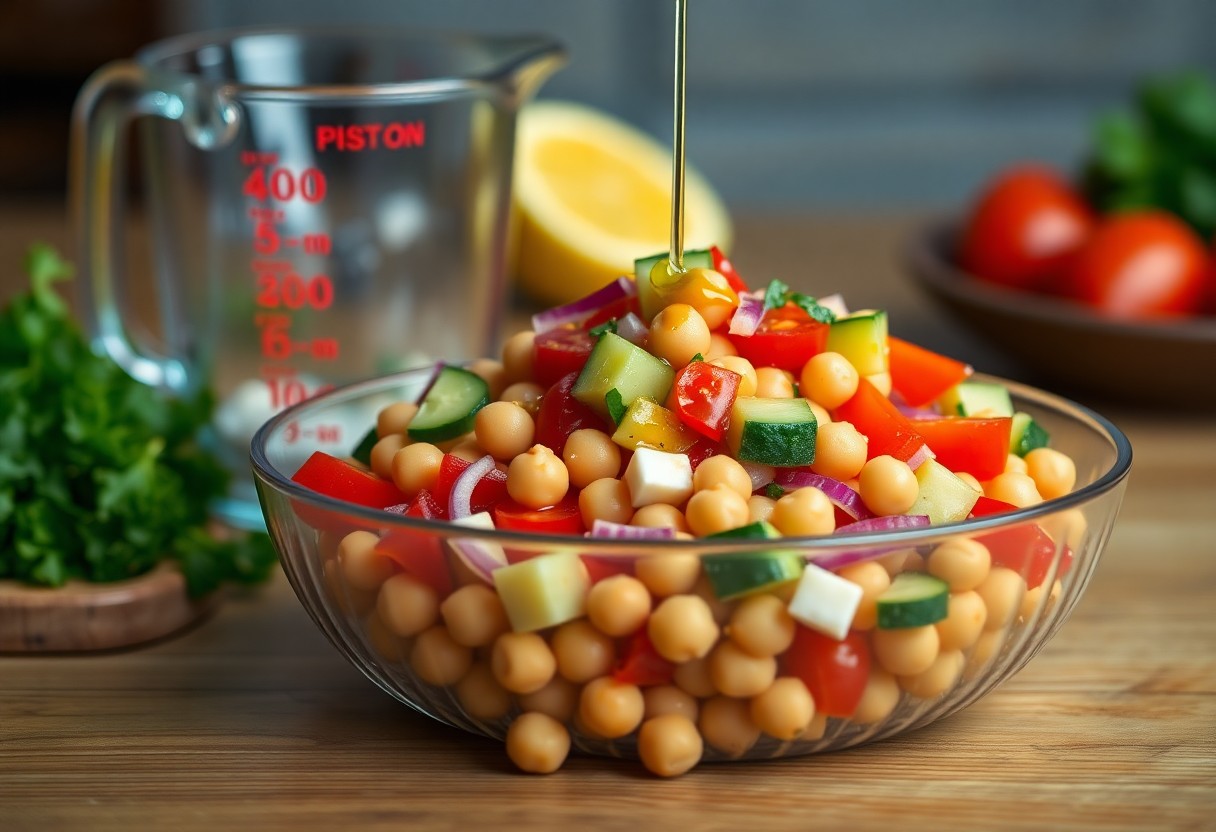You can enhance your diet significantly by incorporating garbanzo beans, also known as chickpeas. These legumes are packed with necessary nutrients, offering a wealth of health benefits, from promoting heart health to aiding digestion. With a low calorie content and high protein levels, chickpeas serve as an excellent source of plant-based protein, making them an ideal choice for vegetarians and vegans. In this post, you'll explore the nutritional profile of garbanzo beans, including their calories, protein power, and other key benefits that can enrich your meals and support a balanced diet.

Key Takeaways:
- Garbanzo beans are high in protein, making them an excellent plant-based protein source.
- They are low in calories and rich in fiber, promoting digestive health and satiety.
- Packed with vitamins and minerals, garbanzo beans support overall health and can aid in weight management.
Nutritional Profile of Garbanzo Beans
Garbanzo beans, also known as chickpeas, boast a rich nutritional profile that supports various health benefits. A one-cup serving (164 grams) contains approximately 269 calories, with a balanced mix of macronutrients and micronutrients that promote overall well-being. These legumes provide fiber, protein, and imperative vitamins and minerals, making them an excellent addition to any diet.
Macronutrients
In terms of macronutrients, one cup of cooked garbanzo beans offers around 45 grams of carbohydrates, 14.5 grams of protein, and 4 grams of fat. Their high fiber content, approximately 12.5 grams per serving, aids digestion and helps maintain stable blood sugar levels, contributing to a feeling of fullness that can support weight management.
Micronutrients
Garbanzo beans are also rich in imperative micronutrients. A single serving provides significant amounts of folate, iron, magnesium, phosphorus, and potassium, all of which play vital roles in your body's functioning. For example, folate supports DNA synthesis and repair, while iron is critical for oxygen transport in your blood.
Folate is particularly noteworthy as it plays a key role in preventing neural tube defects during pregnancy. Additionally, magnesium supports muscle and nerve function, helping to regulate various biochemical reactions in your body. Iron, on the other hand, helps combat anemia and fatigue, while potassium is imperative for heart health and blood pressure regulation. With these micronutrients, garbanzo beans contribute to a well-rounded and nutritious diet.

Health Benefits of Chickpeas
Chickpeas provide a myriad of health benefits, making them a versatile addition to your diet. Their nutrient density supports various bodily functions, from boosting energy to enhancing digestive health. Rich in fiber, vitamins, and minerals, chickpeas can help reduce the risk of chronic diseases and contribute to overall well-being.
Heart Health
Your heart can greatly benefit from chickpeas due to their high levels of soluble fiber, which helps lower cholesterol levels. Research shows that regularly consuming chickpeas can reduce blood pressure and promote healthy circulation, ultimately lowering your risk of heart disease.
Weight Management
Incorporating chickpeas into your meals can aid in weight management by promoting satiety. Their high fiber and protein content help you feel full longer, reducing overall calorie intake. Studies suggest that including legumes like chickpeas in your diet can lead to significant weight loss over time.
Choosing chickpeas over processed snacks helps control appetite effectively. For example, a mere half-cup serving packs about 7 grams of protein and 6 grams of fiber, which can sustain you throughout the day. This nutritional combination can curb cravings and support your weight loss goals, making chickpeas a smart choice for those looking to maintain or lose weight while enjoying flavorful dishes.
Protein Content in Garbanzo Beans
Garbanzo beans are an excellent source of plant-based protein, offering approximately 15 grams of protein per cooked cup. This makes them a valuable food choice for those seeking to increase their protein intake, particularly in vegetarian and vegan diets. The protein in chickpeas is highly digestible and contains necessary amino acids, making it an ideal component of a balanced meal.
Plant-Based Protein Source
As a standout plant-based protein, garbanzo beans help you meet your daily protein needs without the saturated fats often found in animal products. Incorporating chickpeas into your meals not only boosts your protein intake but also provides dietary fiber, which enhances overall health. Whether in salads, stews, or purees, these beans ensure you get adequate protein while enjoying diverse culinary applications.
Comparison with Other Legumes
In comparison to other legumes, chickpeas hold their own in protein content and nutritional benefits. For instance, black beans and lentils also offer comparable protein levels, but chickpeas stand out for their unique flavor and versatility in dishes. Understanding these differences allows you to make informed decisions about including various legumes in your diet.
Comparison of Protein Content in Common Legumes| Legume Type | Protein per Cooked Cup (grams) |
|---|---|
| Garbanzo Beans (Chickpeas) | 15 |
| Black Beans | 15.2 |
| Lentils | 18 |
| Pinto Beans | 15.4 |
In this comparison, lentils have the highest protein content at 18 grams per cooked cup, making them a strong competitor in the legume category. However, garbanzo beans provide a unique texture and flavor that can complement various dishes. Including a variety of legumes in your diet, like chickpeas, boosts protein diversity and enables you to enjoy a range of nutrients and flavors.
Caloric Content
Garbanzo beans are known for their low caloric content, making them a smart choice for those looking to manage their weight. A one-cup serving of cooked chickpeas contains approximately 269 calories, allowing you to enjoy a filling and nutritious option without excessive calorie intake.
Serving Size and Calories
A typical serving size of cooked chickpeas is about one cup, which provides not only important nutrients but also a satisfying and hearty addition to your meals. With 269 calories per serving, this portion offers a balanced energy source while being low in fat.
Incorporating into Diet
Adding garbanzo beans to your diet can enhance both nutritional content and flavor variety. Toss them into salads, blend into hummus, or use as a meat substitute in various dishes. Their versatility allows for easy integration into meals, helping you meet protein and fiber goals without exceeding caloric limits.
To effectively incorporate garbanzo beans into your diet, consider making chickpea salads or adding them to soups and stews for extra texture and nutrition. Roasted chickpeas make a great snack, providing a crunchy, guilt-free alternative to chips. Their mild flavor pairs well with spices, so feel free to experiment with different seasoning blends to boost taste and variety. By choosing garbanzo beans regularly, you not only enhance your meals but also optimize your intake of important nutrients.
Culinary Uses of Chickpeas
Chickpeas, or garbanzo beans, are incredibly versatile in the kitchen, lending themselves to a variety of culinary applications. Their nutty flavor and hearty texture make them suitable for salads, stews, and curries. You can also roast them for a crunchy snack or blend them into dips like hummus. Incorporating chickpeas into your meals not only boosts nutrition but also enhances taste and satisfaction.
Popular Dishes
Some of the most popular dishes featuring chickpeas include hummus, falafel, and chickpea curry. Hummus serves as a creamy dip often paired with pita or vegetables, while falafel, deep-fried chickpea balls, make a flavorful addition to wraps or salads. Chickpea curry showcases the beans' ability to absorb spices and complement a robust sauce, creating a nourishing and satisfying meal.
Cooking Methods
You can prepare chickpeas using various methods, including boiling, roasting, and blending. Boiling dried chickpeas requires soaking them overnight, making them tender and ready for salads or stews. Roasting them with spices turns them into a crunchy snack, while blending cooked chickpeas creates smooth dips or spreads.
For boiling, begin by soaking dried chickpeas for 8-12 hours to hydrate them and reduce cooking time. Once soaked, drain and add them to a pot with fresh water, bringing it to a boil before simmering until tender, usually around 1 to 2 hours. Roasting involves tossing cooked or canned chickpeas with your choice of seasonings, then baking them at 400°F until crispy, which typically takes about 20-30 minutes. Blending is straightforward; simply combine cooked chickpeas with tahini, olive oil, lemon juice, and garlic for a classic hummus. Each method enhances the chickpeas in unique ways, making them a staple in your culinary repertoire.
Tips for Storage and Preparation
Store dried chickpeas in an airtight container in a cool, dry place to maintain freshness. For canned chickpeas, keep them in a pantry away from direct sunlight. Once opened, transfer any leftovers to a sealed container in the fridge. You can enhance their flavor by soaking and cooking with spices. For more detailed research on chickpeas, check out Chickpeas and Nutrition: The Latest Research. Knowing proper storage techniques can significantly extend their shelf life.
Dry vs. Canned
Choosing between dry and canned chickpeas depends on your needs. Dried chickpeas require soaking and longer cooking times but provide better control over texture and flavor. Canned chickpeas are convenient and ready to use, making them a time saver, though they may contain added sodium. Both options are nutritious, so decide based on your time and preference.
Cooking Tips
To achieve perfectly cooked chickpeas, start by soaking dried beans overnight to reduce cooking time. When boiling, add a pinch of salt for flavor enhancement. If using canned chickpeas, rinse them thoroughly to decrease sodium content and improve taste. You can also roast cooked chickpeas for a crunchy snack. After refining your technique, you'll appreciate their versatility in various dishes.
- Soak dried chickpeas for 8-12 hours before cooking.
- Use herbs and spices to flavor the cooking water.
- Experiment with different cooking methods like boiling, steaming, or roasting.
- After cooking, you can store leftovers in an airtight container in the fridge for up to five days.
Exploring different cooking methods can elevate your chickpea dishes. Whether you simmer them in soups, mash them for spreads, or roast them for snacks, the possibilities are endless. Aim to balance flavors with spices and toppings to enhance your meals. After trying various techniques, you'll discover your favorite ways to incorporate chickpeas into your diet.
- Start with simple recipes to build your confidence.
- Incorporate chickpeas into salads or grain bowls.
- Use a food processor to create hummus or dips.
- After mastering the basics, begin to innovate with local flavors or seasonal ingredients.
Conclusion
Considering all points, incorporating garbanzo beans into your diet can significantly enhance your nutrition. With a rich profile of protein, fiber, and necessary nutrients, chickpeas support your overall health and provide sustained energy. Their low calorie count and numerous health benefits make them an excellent choice for weight management and digestive health. For more detailed insights, explore Chickpeas: Health benefits and nutritional information to further understand how they can fit into your dietary choices.
FAQ
Q: What are the nutritional benefits of garbanzo beans?
A: Garbanzo beans, or chickpeas, are rich in protein, fiber, vitamins, and minerals. They provide important nutrients like iron, magnesium, potassium, and folate, contributing to better digestion, heart health, and weight management.
Q: How many calories are in a serving of garbanzo beans?
A: A one-cup serving of cooked garbanzo beans contains approximately 269 calories. This calorie count supports balanced meals without excessive energy intake.
Q: How much protein do garbanzo beans contain?
A: A one-cup serving of cooked garbanzo beans has about 14.5 grams of protein. This makes them an excellent plant-based protein source for vegetarians and vegans.
Q: Can garbanzo beans aid in weight management?
A: Yes, the high fiber content in garbanzo beans helps promote satiety, which can reduce overall calorie intake and support weight management efforts.
Q: Are garbanzo beans suitable for people with dietary restrictions?
A: Garbanzo beans are gluten-free, low in fat, and a good choice for various diets, including vegetarian and vegan diets. However, individuals with certain allergies or digestive issues should consult their healthcare provider.



0 Comments